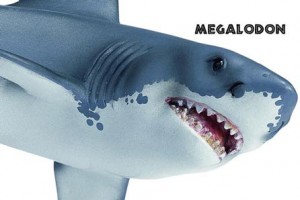Carcharodon megalodon Makes its Debut
At Everything Dinosaur we get lots of requests for our team members to find unusual prehistoric animals through our “Dino Hunt” service. Customers and prospective customers can e-mail us with requests to help them find a particular model or item for their collection or to satisfy the curiosity of a young dinosaur fan.
With our connections to manufacturers and our links to a number of museums and other educational bodies, we can help out most of the time. This can save our customers, a lot of time and effort.
Model of Megalodon
We have received over the last twelve months or so Dino Hunt requests to help people find a suitable model for a Megalodon, a giant shark that lived during the Miocene and Pliocene periods (about 16 -1.6 million years ago). In response to these requests we did some research into shark models in order to try and find a Megalodon model to add to our range. Unfortunately, at this moment in time, there are no specific Megalodon models widely available so we changed tack and began to look at models of modern shark species in order to find a suitable alternative.
We had no idea how many model sharks were out there! However, drawing on the expertise of our contacts with museums – particularly helpful were our friends in the educational department at the Royal Tyrrell museum – Canada; who advised us and supplied us with our own Megalodon cast tooth.
A short-list of potential candidates was drawn up including the Great White Shark model from the Sea Animal series of Schleich of Germany and the Wild Safari Dinos Megalodon shark model.
Megalodon Alternative – Schleich Great White Shark
Picture credit: Everything Dinosaur
The model displays the five gill slots, so typical of a modern shark species and the appropriate layout of fins that Megalodon is believed to have had. The aggressive posture is a nice touch, particularly for an animal calculated to require about ten percent of its body-weight in food each week, just to keep going – no wonder it ate whales!
To view the model Megalodon: Dinosaur and Prehistoric Animal Models.
Prehistoric Shark Colouration
The colouration is also important, like modern Great Whites, this animal was an active predator of surface waters, its large eyes supplemented the other senses that sharks have to help close in our prey. The white underside would have made it difficult for mammals to spot this huge predator if it was swimming above them. The white markings would have made it blend into to the sun dappled surface waters. The slightly curved posture of the model mirrors a big shark’s swimming style accurately and we liked the little touches such as the strongly forked tail and the darkened tips on the pectoral and caudal fins.
Carcharodon megalodon, is sometimes referred to as Carcharocles megalodon, as this animal had a skeleton made of cartilage few elements of the body have been preserved, but we have plenty of teeth – form the large, broad daggers of the anterior dentition to the smaller posterior teeth to be found at the back of the mouth. It is estimated that estimated had about 290 teeth in its jaws. Like dinosaurs these teeth were replaced constantly, with new ones erupting from the jaws as older teeth were broken and worn down.
This giant shark, estimated to reach lengths of perhaps 16 metres or more was named from its spectacular teeth. Carcharodon megalodon means “sharpen, huge tooth”. Scientists still debate whether this animal was very closely related to modern Great White sharks, or whether it shared a common ancestor. Some marine biologists see Megalodon as being more akin to the Tiger Shark (Galeocerdo cuvier). Like Great Whites, Tiger sharks are solitary hunters, palaeontologists believe that adult Megalodons were also solitary.
The Tiger shark was named in honour of Georges Cuvier, the great French naturalist. The Tiger shark is the only member of the genus Galeocerdo, it has been given a separate classification because of its strangely shaped, heavily serrated teeth. The fossil teeth of Megalodon resemble very closely the teeth of a modern Great White, this is why some scientists classify Megalodon with the Great Whites (Carcharodon carcharias).
However, the teeth may be similar as these two animals shared a similar lifestyle and the dentition may be an example of parallel evolution and not indicate that these two genera were closely related.
Slightly worryingly, especially for all those surfers and divers out there, a small group of dedicated cryptozoologists believe that Megalodon is not extinct and that populations are still roaming the oceans of the world today. However, most scientists doubt this; believing that the sightings are possibly over-sized Great Whites or figments of people’s imaginations.
As the Coelacanths have proved anything is possible…![]()
Please note, since this article was first published there has been a revision of the taxonomy of this extinct shark. The consensus is to refer to this shark as Otodus megalodon.







Leave A Comment